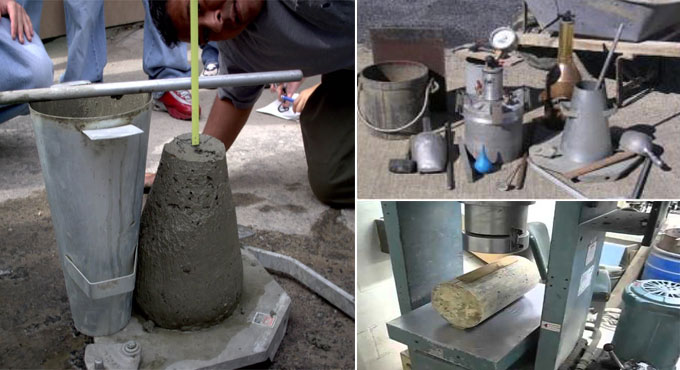
Some vital tests of concrete
As concrete is a vital component of any building construction, the quality and working capacity of concrete should checked properly through various tests prior to apply concrete in construction site.
Given below, the details of some recognized tests :-
1. Slump test
2. Compaction factor test
3. Crushing strength test
1. Slump Test: The purpose of this test is to ascertain the working strength of concrete. To conduct the test, a slump cone is necessary. Slump cone stands for a vessel in the shape of a frustum of a cone having diameter at bottom 200mm and 50mm at top and 300 mm high. This cone is retained over an impenetrable platform and is filled with concrete in four layers.
For 25 times, each layer is compressed with a 16 mm pointed rod. Once the filling is finished the cone is delicately lifted up. Reduction in the height of the concrete is known as slump. The working capacity of concrete is increased significantly if the slump is higher.
2. Compaction Factor Test: This test is performed in the laboratory with various equipments like two hoppers and a cylinder attached to a stand. The dimensions and the distances among the three vessels are standardized. In Vessel A and B, there are hinged bottoms and in cylinder C, there is fixed bottom. Top vessel A is filled with the concrete that should be examined carefully.
Once it is filled, the hinged door is opened. Concrete is amassed in vessel B. Then the hinged door of B is opened to assemble concrete in cylinder C. The concrete in cylinder C is weighted.
Suppose, the weight is provided as W1. Now, the cylinder is further filled with the sample of concrete in 50 mm layers, that is compacted by ramming and vibrating. Then, the weight of compacted concrete is set. Assume this weight as W2. The proportion of W1/W2 is defined as compaction factor.
3. Crushing Strength Test: Metallic moulds with size 150 mm ? 150 mm ? 150 mm are applied for casting concrete cubes. Prior to fill mould, it?s inside surface is perfectly oiled on its inner surfaces in order that the cubes can be simply segregated. Fresh cube is filled with concrete in such a way that it can be examined in 3 layers and retained in the room. After 24 hours, cube is eliminated from the mould and put under water for curing.
Once 28 days of curing is completed, the cubes are examined in the compression testing machine. Under this test, the cubes are arranged over the smooth surface which make contact with side plates of mould. The crushing load is recorded and crushing strength is detected as load divided with surface area (150 ? 150 mm2).
Code indicates the acceptable strength of concrete for 3 days and 7 days for evaluating the strength of concrete quickly. Acceptable Properties of Concrete, exact quality and quantity of cement, fine aggregate, coarse aggregate and water should be employed in order that the green concrete contains the following properties:
(a) Desired workability
(b) No segregation in transporting and placing
(c) No bleeding and
(d) No harshness.
Hardened concrete should contain the following properties :-
(a) Essential characteristic strength
(b) Minimal dimensional changes
(c) Strong strength
(d) Water-resistant
(e) Sound resistance to wear and tear.


